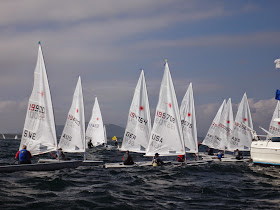By Doug
Bruce in Australia was
reading some old posts and sent us comments and questions. These along with my
comments (in italics) are reprinted with his permission:
I've been reading a few
of your older posts and was wondering if you could do an
analysis of Lijia Xu's extraordinary medal race in the last Olympics? One thing that worked
for her, that didn't work in the men's race, was the right side on the
beats. In one of the aerial shots there are Lasers way in the
background. We can assume that these were the men waiting to start their race.
It is interesting that the right side did not work for the men.
She ducked the fleet
soon after the start and went right. Was this because she was bailing out and
struggling to hold her lane? Usually if you are quick, you stick close to the
leaders and match them. For a medal race, she was really taking a risk I
thought, but was she? I watched the video again and recall reading
that her coach had told her to go right. If that was correct, the risk was not
following her coach's instructions.
Her downwind penalty.
This rule can be very subjective sometimes. What is your take on her penalty? Was
she really breaking Rule 42 at the time? Did she change her style after the
penalty? She was still fast! I could not see anything bad, but at 19:00 you
could see the judge boat closing in. The announcers said that this was the
first yellow flag they had seen so the fleet must have been clean. The call was
really picky in my opinion. Thankfully, it did not affect the final results.
After her penalty, she
makes ground incredibly quickly to regain the lead. How did she do that in such
a competitive fleet? She was lighter than the other leaders, but she also seemed
to have picked up some pressure by sailing between NED and GBR. Some call this
the 'venturi effect.'
 |
| At 20:11, CHI is in the middle perhaps gaining from the 'venturi effect?' |
She wanted to go around
the right gate but did not have the inside, so she luffed hard and bore away to
gain the lead and the mark position. That's not quite how I saw it. She was between
NED and GBR about to round the left (or right) gate in second place. At 20:23
GBR tried to cut inside and took CHI's wind, and CHI would have slowed down. So
CHI defended by luffing sharply and regained the lead. Great move.
What I find interesting
is that the leaders chose the right gate to go left which did not work on the
first beat.
When GBR tried to go inside
CHI, GBR gave up getting room at the left gate. So why did CHI not simply head
for that gate to round and then go right as planned? Luffing two boats,
rounding the right gate, and then tacking seemed a lot riskier. And why did GBR give up the left gate?
Would that happen at the
front of the fleet in a Masters Worlds? It's very competitive at the front of the
fleet. I would not be surprised to see exactly the same moves.
She then gets ballsy and
goes right again up the beat. Why didn't she cover? Great question. At
21:27 she tacks away.
 |
| Rather than stay with the leaders, CHI does a risky cross to go right on her own. |
The factors at that
moment:
● Cover her competition by continuing
left, or
● Protect against the boats that were
going to the favored right, or
● Follow her coach's instructions.
My guess this that she
chose the latter, even though it was dangerous because she could easily have
fouled NED by tacking. Even on the third beat while in the lead, CHI again
chose to go right.
Anything else that for
you is significant about her race and what she and her competitors may have
been doing differently? Watching the race again, I was impressed by how smooth
CHI looked going upwind. The others, especially NED, seemed to be wrestling
with their boats.
This was an impressive
race because there was a virtual 4-way tie for the gold medal in this medal
race. Here's what we can all learn from this gold medal performance:
● Have a plan and if you're confident with
your speed, stick to it.
● Be in shape. CHI did not seem to be
breathing at all hard.
● Courses now have downwind finishes, so
downwind speed rules.
Final comments from
Bruce: One thing I had never
considered when CHI gained so much so quickly after her penalty was the
possibility of the venturi effect. Wow, if that was what it was, it was very
powerful. Sure she was the lightweight of the fleet at 60kg but I couldn't
imagine her weight making that much of a difference so quickly.
As you say, XU looked so
smooth upwind and I also put that down to supreme fitness. She seems quite
tallish too, so had great leverage from consistent and seemingly effortless
straight leg hiking.
The race was super instructive in so many respects.







